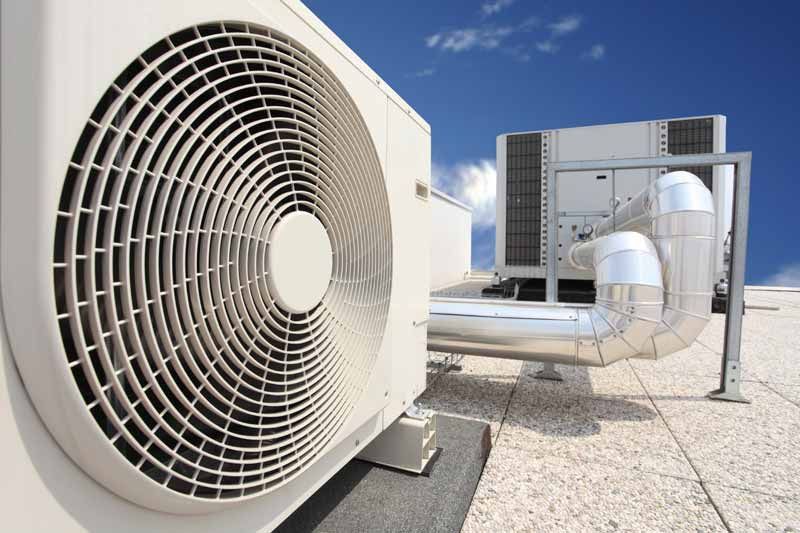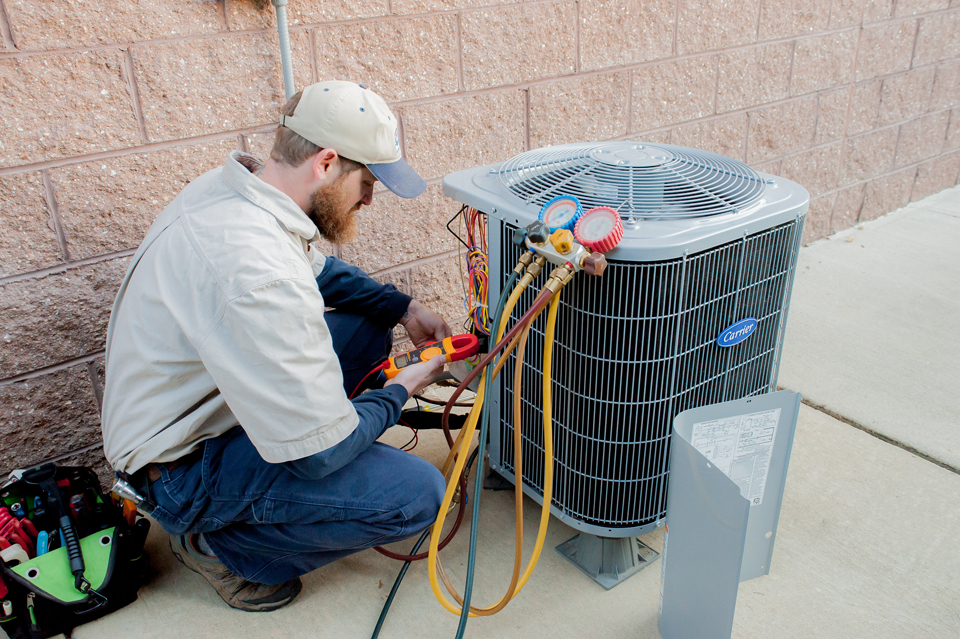Just How a Heat Pump and Furnace Collaborate to Optimize Your Home's Heating Efficiency
Recognizing how a heatpump and heater interact is essential for home owners looking for reliable heating remedies. Each system has its strengths, providing a balanced strategy to home comfort. The heatpump excels in modest temperatures, while the heating system provides quick warmth throughout extreme cold. This synergy not just reduces power prices however also boosts the life expectancy of both home appliances. What aspects affect this partnership, and just how can house owners maximize their benefits?
Recognizing Warmth Pumps: Just How They Function
Several individuals may be unfamiliar with their internal operations, warmth pumps play a crucial function in modern home heating systems. These tools operate by moving heat from one place to an additional, utilizing the principles of thermodynamics. In colder months, a heatpump removes heat from the outdoors air, ground, or water, and transfers it inside to warm up the living space. On the other hand, throughout warmer months, it can turn around the procedure, working as an a/c by removing warmth from inside to the outside.Heat pumps contain an evaporator, condenser, expansion, and compressor valve. The refrigerant within the system absorbs warmth as it vaporizes at reduced temperatures and stress. The compressor after that raises the stress and temperature of the cooling agent, enabling it to launch heat as it condenses. This efficient process can significantly reduce power intake compared to conventional heating techniques, making warm pumps a sustainable option for environment control in homes.
The Function of Heaters in Home Heating
Furnaces play a vital duty in home heating by giving a reputable resource of warmth during the colder months. They run by generating warm with combustion or electric resistance, dispersing it throughout the home using air ducts or radiant systems. The efficiency of a heater is usually determined by its Annual Fuel Usage Effectiveness (AFUE) ranking, which shows how effectively the device converts fuel right into heat.Furnaces can utilize numerous energy resources, consisting of natural gas, oil, gas, or electricity, allowing home owners to pick the most ideal option for their demands. Unlike heatpump, which might struggle in extreme cool, heating systems keep regular performance, guaranteeing that indoor temperature levels remain comfy no matter exterior conditions. Additionally, modern-day heating systems often come equipped with sophisticated modern technology, such as smart thermostats and variable-speed blowers, boosting their performance and responsiveness. This versatility makes heating systems a crucial element in all-inclusive home heating approaches.

Advantages of Using Both Solutions With Each Other
Incorporating the strengths of both heaters and heat pumps can bring about a more reliable and effective home heating solution. Making use of both systems permits house owners to capitalize on the heat pump's power performance during milder temperatures while depending on the heating system for even more severe cold conditions. This dual technique can greatly reduce energy costs, as heatpump eat less electrical energy than traditional home heating approaches when temperatures are moderate.Additionally, utilizing both systems with each other can enhance convenience degrees in the home. Warm pumps can give consistent, also home heating, while heaters can rapidly increase ambient temperatures when needed. Additionally, the integration of both systems can prolong the lifespan of equipment by lowering damage on each system, as they share the workload. Eventually, house owners can appreciate a well balanced, economical heating solution that changes perfectly to differing climate condition, guaranteeing a warm and inviting home throughout the wintertime months.
Just How Warmth Pumps and Furnaces Complement Each Various Other
When house owners integrate heatpump and heaters, they develop a complementary furnace that takes full advantage of effectiveness and comfort. Heatpump operate by moving warm from the outside air or ground, making them very efficient in moderate environments. They stand out during milder temperature levels, giving affordable heating. On the other hand, heating systems create warmth via burning or electric resistance, supplying solid, immediate warmth during extreme cool conditions.The mix of these two systems permits dynamic adjustments based on temperature fluctuations. Throughout warmer months or milder winter months days, the heatpump can take the lead, saving power and minimizing expenses. As temperatures decline, the furnace can seamlessly engage, guaranteeing regular heat throughout the home. This synergy not only enhances power use however additionally improves the life expectancy of both systems, as each unit runs within its excellent efficiency range. Together, they produce a well balanced atmosphere that adjusts to differing environment demands.
Enhancing Efficiency: Tips for Homeowners
House owners can improve visit their home heating performance via several sensible methods. Establishing a normal maintenance schedule, incorporating smart thermostat innovation, and executing reliable insulation and securing solutions are key steps. These steps not only boost convenience but also decrease energy costs.
Normal Maintenance Arrange
To assure optimal home heating performance, establishing a regular maintenance schedule is necessary for any home. Property owners need to prioritize routine inspections of both warm pumps and heating systems to determine peak performance. This includes changing air filters every one to three months, as stopped up filters can greatly reduce efficiency. In addition, scheduling professional maintenance a minimum of when a year permits service technicians to determine and resolve potential problems prior to they rise. House owners need to likewise cleanse the heatpump's exterior device to avoid particles buildup that can prevent airflow. By adhering to a routine upkeep schedule, homeowners not only enhance their furnace' performance yet likewise expand their life-span, bring about higher comfort and minimized power costs throughout the colder months.
Smart Thermostat Assimilation
Incorporating a smart thermostat right into a home heater can considerably improve energy effectiveness, especially as it enables specific control over temperature setups. These tools can learn the home owner's routine and choices, automatically changing the temperature level to optimize convenience while reducing energy usage. For circumstances, they can reduce heating during times when the home is vacant, lowering unneeded intake. Lots of smart thermostats this contact form additionally supply real-time power use data, allowing property owners to make educated choices regarding their heating behaviors. Additionally, remote gain access to via smart device applications permits customers to readjust settings from anywhere, guaranteeing the home is warm upon return. Generally, wise thermostat combination not just enhances comfort but substantially adds to energy cost savings and effectiveness.
Insulation and Sealing Solutions
Smart thermostats play a vital function in energy effectiveness, but their effectiveness can be greatly improved by proper insulation and sealing solutions. House owners ought to focus on shielding attics, floors, and wall surfaces to decrease heat loss. Premium insulation materials, such as spray foam or fiberglass, can considerably enhance thermal resistance. In addition, securing spaces around home windows, air ducts, and doors prevents cold air infiltration and warmth escape. Weatherstripping and caulking work methods for resolving these leaks - heat pump service. Routine assessments for air leaks, together with the use of blower door examinations, can aid identify problem locations. By investing in insulation and sealing, property owners can optimize the performance of their heater, inevitably bring about minimized power usage and lower energy expenses
Typical Misconceptions About Heat Pumps and Furnaces
What false impressions surround heatpump and heaters? Lots of individuals wrongly think that heatpump are ineffective in cooler environments. In truth, contemporary heatpump are developed to operate effectively even in reduced temperature levels, offering trusted home heating throughout winter season. An additional typical myth is that furnaces are always more effective than heat pumps. Nonetheless, this depends on the particular energy resources and efficiency rankings of the systems in concern. Some may also think that utilizing both systems simultaneously is unneeded, but in truth, this combination can maximize heating effectiveness, particularly during severe climate condition. Additionally, individuals commonly assume that heat pumps need continuous upkeep, when in truth, they have similar upkeep requires to standard home heating systems. By exposing these misconceptions, homeowners can make more informed choices regarding their home heating options, ultimately resulting in improved comfort and energy effectiveness in their homes.
Maintenance Factors To Consider for Combined Equipments

Regularly Asked Questions
Can Warm Pumps Job Effectively in Very Cold Climates?
Heatpump can have a hard time in extremely cold climates as a result of lowered efficiency and heat removal constraints. Nevertheless, developments in innovation have brought about versions created for far better efficiency in such problems, boosting their stability in harsh atmospheres.
Just How Lengthy Do Warm Pumps and Furnaces Usually Last?
Heatpump normally last 15 to 20 years, while heaters have a life expectancy of 15 to thirty years. Normal upkeep can prolong their durability, ensuring efficient operation and decreasing the requirement for early substitutes.

What Is the Typical Cost of Setting Up Both Equipments?
The typical cost of setting up both a warmth pump and a heating system generally varies in between $5,000 to $10,000 - furnace replacement. Factors affecting this price consist of system size, installation intricacy, and regional labor rates
Are There Tax Incentives for Utilizing Energy-Efficient Home Heating Equipments?
Lots of property owners ask about tax obligation motivations for energy-efficient heater. Different federal and state programs frequently supply debts or rebates, motivating the fostering of lasting innovations to lower power intake and promote environmental obligation.
How Do I Select the Right Dimension Heatpump and Heater?
Selecting the ideal dimension warm pump and heating system includes computing the home's square video footage, taking into consideration insulation top quality, and examining neighborhood environment. Consulting a specialist can assure perfect system efficiency and energy efficiency based on specific demands. ductless mini splits. Recognizing exactly how a warmth pump and heating system job with each other is crucial for house owners seeking efficient home heating options. In chillier months, a warm pump extracts heat from the outdoors air, ground, or water, and transfers it inside your home to warm up the living area. When property owners integrate warm pumps and heaters, they produce a corresponding heating system that maximizes efficiency and convenience. Warm pumps run by moving heat from the outside air or ground, making them very efficient in modest environments. Heat pumps can have a hard time in extremely chilly environments due to lowered efficiency and warm removal limitations
Comments on “Should You Choose ductless mini splits? HVAC Specialist Tips”